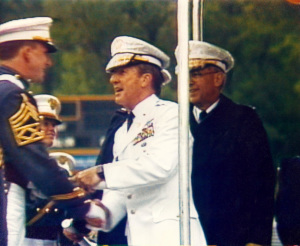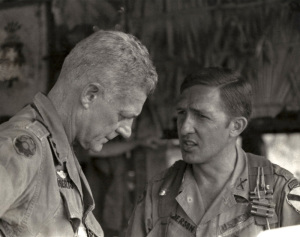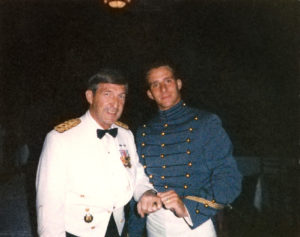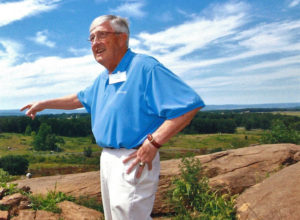General James L. Anderson
General Jim Anderson Overview
 My dad, General (retired) Jim Anderson, served active duty in the U. S. Army for 41 years. He graduated from West Point in 1956, became an Army Ranger and was later an instructor at the Ranger School. He served two tours in Vietnam earning many combat medals to include 2 Purple Hearts, 2 Bronze Stars for Valor, and a Silver Star.
My dad, General (retired) Jim Anderson, served active duty in the U. S. Army for 41 years. He graduated from West Point in 1956, became an Army Ranger and was later an instructor at the Ranger School. He served two tours in Vietnam earning many combat medals to include 2 Purple Hearts, 2 Bronze Stars for Valor, and a Silver Star.
He became the Master of the Sword (click to see history of the title) a.k.a. Department Head, Department of Physical Education) in 1973 and spent the next 24 years of his life dedicated to developing leaders of character at his alma mater. Since retiring from the military in 1997, he has dedicated his life to promoting the value of character-based leadership impacting more than 100 Fortune 500 companies and multiple governmental agencies. His complete bio is listed below.
Childhood and College:
General Jim Anderson was raised in a county orphanage in New Lexington, Ohio. His father left his children at the orphanage soon after his wife’s death. The orphanage was a working farm that was run by a strict but caring German couple. Every child had chores. Some of young Jim’s responsibilities included milking the cows and feeding the chickens every morning before school. Every Christmas, he had was given the privilege of reading the Christmas story (Luke 2:1-21) from the King James Version. In high school, he graduated at the top of his class and was quarterback and captain of his football team. He was recruited by Woody Hayes to play football at Ohio State, but realized “I didn’t have a particularly good arm and I wasn’t very fast.” Knowing that the only way to afford college was to get a scholarship, he applied to West Point.
After graduating from high school in 1951, he had to wait a year to get his congressional nomination to West Point. He enlisted in the fledgling Air Force, was stationed at Lackland AFB in San Antonio and was immediately promoted to Sergeant because of his high testing scores. Soon however, he was assigned to the United States Military Academy Prep School and entered West Point in the summer of 1952.
During his four years at West Point, he played varsity lacrosse. His best memory of lacrosse was playing against NFL football great Jim Brown, while Brown was at Syracuse. Jim Anderson graduated from the United States Military Academy with the Class of 1956.
The Army
 Upon graduation, General Anderson was commissioned in the Infantry, attended Airborne School and was honor graduate from Ranger School. He served in Germany from 1957-1960. He returned to the Ranger detachment as an instructor and Company Commander of the 1st Ranger Company from 1960-1963.
Upon graduation, General Anderson was commissioned in the Infantry, attended Airborne School and was honor graduate from Ranger School. He served in Germany from 1957-1960. He returned to the Ranger detachment as an instructor and Company Commander of the 1st Ranger Company from 1960-1963.
Recognized as an expert in counter insurgency warfare, General Anderson served in Vietnam from 1963-64 as a Battalion Advisor to the Vietnamese 9th Infantry Division. In October 1963, he assisted the Vietnamese Battalion Commander whose unit that was in danger of being over run, in leading a bayonet assault that routed a numerically superior attacking force. It was the first time the Army of the Republic of Vietnam defeated a major Viet Cong ambush during the Vietnam War.
For his actions in Vietnam during this tour, General Anderson was awarded two Bronze Stars and the Purple Heart. General Anderson would again return to Vietnam in 1969 after earning a Masters Degree at Indiana University and serving as an instructor at West Point from 1965-1968. While at West Point, he received a personal call from General Creighton Abrams with an invitation to be the general’s aide in Vietnam. General Anderson agreed to the assignment on the condition he would have the opportunity to command a battalion while he was in country as well.
After six months as Executive Officer and Aide to General Creighton Abrams, MAACV commander, then Lieutenant Colonel Anderson would volunteer to command the 1st Battalion, 5th Cavalry, 1st Cavalry Division. General Abrams and others told him the unit was suffering from the same racial discord affecting the much of the United States in that era.
Upon taking command, he held meetings with the soldiers and non-commissioned officers in his unit to hear the concerns of people on both sides of the debate. He often spent evenings walking the perimeter of his fire support base speaking with African American soldiers and Caucasian soldiers about their lives and listening to their thoughts on racial issues.
By gaining the trust and respect of the soldiers, symbols like a Confederate Battle Flag and Black Power Salutes soon disappeared from the unit. With tensions eased, he would lead the battalion during the invasion of Cambodia in May 1970. 1/5 Cavalry made the deepest penetration into Cambodia of any American force in Vietnam. The unit was awarded the Valorous Unit Citation for this action.
In other action, General Anderson was personally involved in an attack on a NVA bunker complex. The battalion’s standing order was that no American bodies would be left on the battlefield. When a company commander refused to lead his men in an effort to retrieve three of his soldiers’ bodies, General Anderson relieved the captain, assigned a new company commander, and participated in the assualt to retrieve the bodies.
Later, while his fire support base was being overrun by a North Vietnamese force led by sappers, General Anderson coordinated the counterattack that defeated the larger enemy force and was awarded the Silver Star for his actions in this battle. He was also awarded the Legion of Merit and twelve Air Medals during this tour.
Upon his return from Vietnam in 1970, General Anderson would serve at the Pentagon in the Office of the Special Assistant for the Modern Volunteer Army. The Army had relied on the draft since the Civil War. General Anderson was responsible for developing the framework and strategies that led the Army to become the highly effective and highly trained all volunteer force that serves America today in Iraq and Afghanistan.
After completing his doctorate in Exercise Physiology at Indiana University, General Anderson was the promoted to Colonel, and became the seventeenth “Master of the Sword”, the Professor and Head of the Department of Physical Education in 1973.
The Master of The Sword
 General Anderson served twenty-seven years on faculty at West Point, twenty-four of those as the “Master of the Sword”, the Professor and Head of the Department of Physical Education from 1973-1997. During those twenty-four years 22,756 cadets graduated from the Academy. At the time of his retirement, there were 38,910 living graduates. Meaning that 58% of the living graduates at the time of his retirement recognized him as their “Master of the Sword”.
General Anderson served twenty-seven years on faculty at West Point, twenty-four of those as the “Master of the Sword”, the Professor and Head of the Department of Physical Education from 1973-1997. During those twenty-four years 22,756 cadets graduated from the Academy. At the time of his retirement, there were 38,910 living graduates. Meaning that 58% of the living graduates at the time of his retirement recognized him as their “Master of the Sword”.
During his tenure as Department Head, General Anderson believed it was his duty to prepare West Point and its cadets for their role in leading the United States Army into the future. He led in the development of physical standards of performance for women at the West Point. Predicting the inclusion of women at West Point, General Anderson conducted extensive studies to determine the physical capabilities of young women who would soon be part of the Long Grey Line. His research and influence convinced Congress that women were physiologically different from men resulting in the rewriting of the bill that admitted the first women to West Point. His foresight was instrumental in making the transition of women coming into West Point in 1976, smooth, sensible and with fewer problems than the other academies. Of the 3710 women to graduate from West Point since 1980, the first 1717 (46%) graduated with General Anderson as “Master of the Sword.”
In 1977, General Anderson authored the best seller The West Point Fitness and Diet Book, one of the first books leading America into the “fitness revolution”. He was also one of the founders and original editors of the Yearbook of Sports Medicine, which has been recognized as the definitive referred journal for sports medicine research around the world. From 1978 though 1998 he participated in writing and publishing all volumes. In 1981, he also wrote The Competitive Edge: The West Point Guide for the Weekend Athlete.
In May 1997, he retired from the United States Army as a Brigadier General. The Department of Physical Education annually awards “The Anderson Excellence in Teaching Award” in his honor.
Civilian Life
After retirement, General Anderson turned from developing leaders of character for the United States Army to developing leaders of character in the civilian sector. From 1997-2005 General Anderson was the primary leadership consultant and trainer with one Fortune 50 company. He used the Purpose of the United States Military Academy as the foundation for a training program on Character Based Leadership.
He personally led this training impacting everyone from the Vice President of Worldwide Human Resources and most mid-level leaders and sales representatives hired in those years.  Currently, General Anderson is part of the faculty at The Lincoln Leadership Institute (link) at Gettysburg, PA, which uses the Battle of Gettysburg to teach lessons of leadership to both corporate clients and major governmental agencies. Thousands of leaders from Apple, Shell, Black and Decker, Novartis, the Department of Defense, the Office of the Inspector General and others have learned the lessons of Character Based Leadership on the Gettysburg Battlefield from General Anderson.
Currently, General Anderson is part of the faculty at The Lincoln Leadership Institute (link) at Gettysburg, PA, which uses the Battle of Gettysburg to teach lessons of leadership to both corporate clients and major governmental agencies. Thousands of leaders from Apple, Shell, Black and Decker, Novartis, the Department of Defense, the Office of the Inspector General and others have learned the lessons of Character Based Leadership on the Gettysburg Battlefield from General Anderson.
General Anderson continues to serve others in his community and abroad. He serves as president of his Methodist Church Board and has led his congregation in a campaign to build an orphanage and financially support the children of that orphanage in Brazil. Two Sundays a month he is the lead cook at the local soup kitchen making breakfast for the less fortunate.
General James L. Anderson led with courage in combat. His visionary leadership to West Point and the Corps of Cadets as the longest serving Master of the Sword in history ensured the effectiveness of our fighting force for decades after his retirement. His continuing leadership in the civilian sector guarantees the principles of service, honor, and character will continue to be heard in boardrooms across our country.
I am honored to call him my father and now co-author. Most of the lessons in leadership I learned in life started with my father. I am excited to get to work with him on leadership projects now and into the future.
